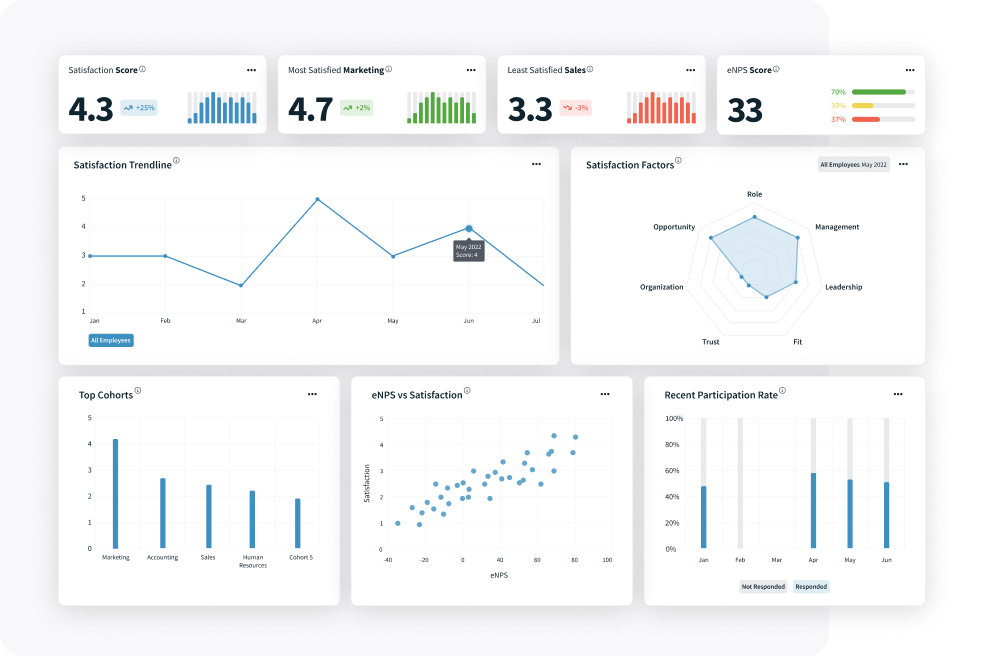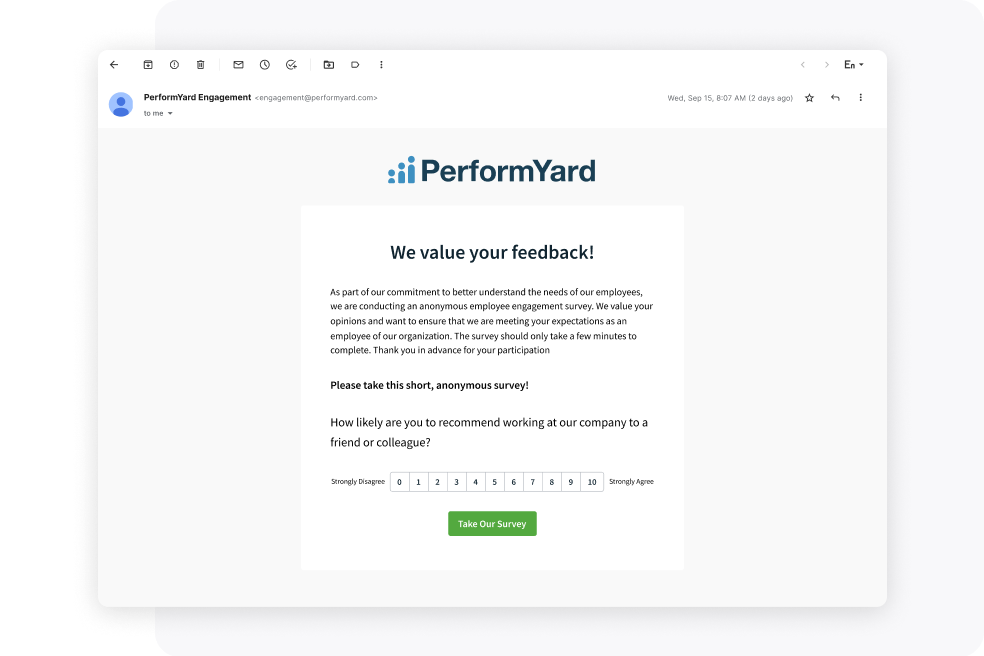8 Key Benefits of Employee Engagement Platforms
Employee engagement platforms are technology solutions that help companies implement and maintain employee engagement programs. These platforms have tools that facilitate communication, recognition, surveys, and feedback.
Many companies are looking for ways to improve employee engagement because better employee engagement means higher profitability. A Gallup survey showed that the profitability of companies with highly engaged employees is higher by 21%. Therefore, wider adoption of employee engagement platforms is expected to continue in the foreseeable future.
Benefits of Employee Engagement Platforms include:
- Increased productivity: Employee engagement software helps to improve productivity. Engaged employees are likelier to put in more effort and go above and beyond at work. This leads to better results and increases productivity. In a 2023 Gartner survey, employees who were energized and excited about their work were 31% more likely to put in discretionary effort and they contributed 15% more at work.
- Teamwork: Engagement platforms improve collaboration because there’s better communication and feedback, which boosts the camaraderie at work.
- Higher Employee Retention: Research has shown that companies with engaged employees have better retention rates. Employees are more likely to stay in a company where they are heard, recognized, and rewarded.
- Improved communication: Engagement platforms improve communication by providing a space for employees to be heard and management can give feedback while ensuring that issues raised are addressed.
- Motivation: Employees are motivated to perform better when their contributions are recognized and rewarded. Recognition and reward features help to achieve this.
- Increase innovation: Engaged employees are more likely to contribute ideas and solutions, and this fosters a culture of innovation in the company.
- Job satisfaction: When employees are engaged, there’s enhanced job satisfaction because factors such as career development and growth opportunities, as well as appreciation, job security, and positive work culture, are present.
- Lower absenteeism: A Gallup study revealed that absenteeism reduces by 81% when employees are engaged. Engaged employees are usually motivated and willing to come to work.
What are some examples of Employee Engagement platforms?
PerformYard
PerformYard offers a two-in-one solution: performance management software and employee engagement software. The solution includes features for surveys, continuous feedback, and various forms of visual data, including a data analysis dashboard and employee cohort analysis. It also provides dedicated support for all solutions.

Lattice
Lattice employee engagement platform has features such as surveys and benchmarks which help to take action on feedback. Teams can view all tasks in progress and the Admin dashboard allows HR teams to create custom review questions. The challenges with the platform include usability issues and limited integration options.
15Five
15Five’s platform combines continuous feedback, objectives and key results (OKRs), and weekly check-ins. It encourages regular communication and feedback, helps to align individual objectives with company goals, and facilitates recognition and appreciation. The shortcomings of the platform included limited integration capabilities and high implementation costs.
Free employee engagement tools
Overview of free tools
Free employee engagement tools help businesses enhance employee engagement, improve communication, and foster a more positive and productive work environment. Free tools can be advantageous to small businesses that may not be able to afford Employee engagement software.
Advantages and limitations
Advantages of free engagement tools include:
- No costs are required: they can be adopted without any financial investment
- Easy Implementation: They are usually easy to set up and use.
- Improve communication: Help to facilitate better communication and collaboration within the organization and teams.
- Feedback and Insights: They collect and analyze employee feedback to improve engagement strategies.
- Scalable: There are upgrade options for the tools as the organization grows, though these may be paid options.
Some of the drawbacks of free tools include:
- Limited features: Free tools usually lack some features available in paid plans.
- Data privacy and security: Free tools may not offer the same level of data protection and privacy as paid plans.
- User limitations: Free tools usually have a cap on the number of users, making them unsuitable for companies with a high number of employees.
- Storage limitations: Free plans often have restricted storage space, and this will be a problem for managing large volumes of data over time.
Best free tools available
Several tools and platforms can be used to measure employee engagement, but it should be noted most are either free versions with very limited features or trial versions that can be used for a limited time. They however have valuable capabilities for organizations who want to improve employee engagement without incurring additional costs. Examples include:
Slack
Slack provides real-time communication at work and users can create “channels” by which users can organize conversations by team or project. Features in Slack include Direct messaging, one-on-one or group chats for communication, file sharing to send documents, photos, or videos, and integration features to connect with apps like Google Drive, Trello, and various survey tools. The tool is easy to use and its features help to improve productivity and visibility.
Officevibe
Officevibe’s free plan provides real-time feedback and actionable insights. Its main features include pulse surveys for regular feedback collection, one-on-one meeting templates that enhance communication, customizable survey questions, and basic reporting and analytics. One major disadvantage of the free plan is that only one team with one assigned manager can be created, and it’s not suitable for companies with several teams.
Bitrix24
It offers various tools for employee engagement and collaboration. Its major features include communication tools such as chat video calls and social intranet. There are also task and project management features, document sharing, and activity streams for updates and recognition. The downsides of the free version include storage, which is limited to 5G and certain features are not included.
Survey Monkey Basic Plan
This is a free online tool for creating and distributing surveys. The main features include access to basic survey templates, real-time results collection and analysis, and data export functionalities to CSV or Excel. The major drawbacks of the basic plan include the limitation of the number of survey questions to 10 and the inability to edit questions on surveys with more than 10 questions. Also, only surveys with 10 questions or less can be copied.
How do employee experience platforms enhance engagement?
Personalized employee experiences
Employee engagement and employee experience are closely linked, with personalized employee experience playing a key role in fostering engagement. Personalized employee experience is when the unique needs and situations of employees are considered to deliver a work experience that fits their needs.
For example, onboarding can be tailored to fit the role, experience, and skills of an employee so that they can have an onboarding experience that meets their particular needs. These personalized experiences can make employees happier and more engaged at work.
Feedback and recognition systems
Feedback helps to ensure that employee concerns are heard, and understood and will be addressed by management, while recognition initiatives create a sense of belonging and value among employees, leading to increased engagement at work.
Integration with HR and other systems
When HR systems work efficiently, employees can work and communicate effectively. An integrated HR system helps to save time, produce better results, and reduce frustration at work. This in turn improves engagement and productivity.
What techniques and tools are effective for employee engagement?
Surveys and feedback tools
Survey and feedback tools are some of the most important tools in measuring and improving employee engagement. They facilitate a better understanding of employees and connect the workforce to management by providing insight into employees’ experiences.

Recognition and rewards systems
When employee contributions are recognized and rewarded, they are usually willing to do more and go the extra mile. Recognition systems help to motivate employees and give them a sense of purpose, which will improve engagement at work.
Communication and collaboration tools
Communication tools are crucial to employee engagement. These tools help employees connect more effectively and this boosts collaboration on work projects. Better communication also helps to improve company culture and create a sense of belonging.
How can performance management platforms help in employee engagement?
Encouraging communication and collaboration
Performance management systems can improve communication and collaboration through check-in and feedback features. These features allow managers and team members to have conversations around work goals, give updates, obtain crucial information, and have discussions. These check-ins improve communication and collaboration at work.
Building a sense of community
When employees receive recognition and praise at work, they feel valued and develop a sense of belonging. Recognition features on performance management platforms can help to implement this continuously and effectively and prevent overlooking the contributions of any employee.
Promoting company culture and values
All aspects of a positive company culture such as inclusion, teamwork, belonging, well-being, and work-life balance can be implemented and enhanced through performance management features that promote these values. For example, to promote inclusion and diversity, performance management platforms should use inclusive language, obtain feedback from multiple sources to avoid bias and recognize employees who display inclusive behaviors.
Conclusion
Employee engagement platforms play a big role in today’s workplace and companies try to improve their employee engagement by adopting tools and platforms that help to achieve this. While there are many great engagement platforms, companies need to assess the benefits and downsides of these tools and platforms to make the best decision on which one best suits them. There are also free tools and platforms that smaller businesses can take advantage of to improve their employee engagement at no cost. Some tools measure performance and are also great for employee engagement, such as the PerformYard platform.




.jpg)
